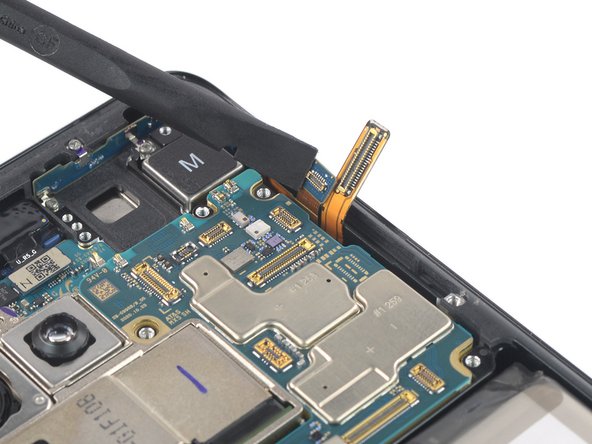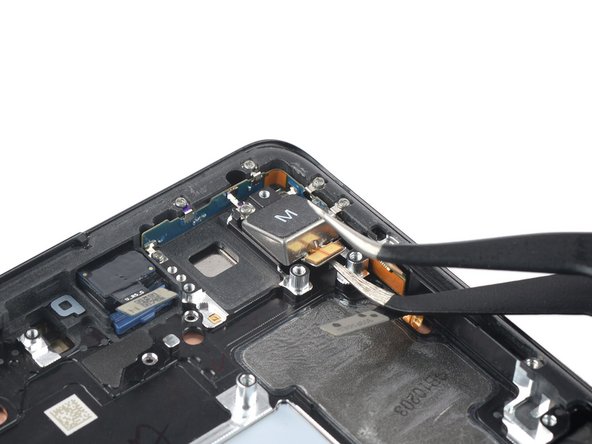Samsung Galaxy S21 Ultra Vibration Motor Replacement Guide
Duration: 45 minutes
Steps: 33 Steps
Hey there, it’s time to show some love to your SM-G998B/DS! Get ready to bring out its best self with a touch of Salvation Repair magic. Let’s make this repair journey a smooth and enjoyable ride. If you need help, you can always schedule a repair.
Ready to give your Samsung Galaxy S21 Ultra a little TLC? This guide will walk you through replacing the vibration motor with ease! We’re focusing on the SM-G998B/DS (international) model here, but if you have a different version, just a heads up that there’s an extra antenna cable hanging out in the midframe. While you don’t have to disconnect the interconnect cables to swap out the screen, we totally recommend it! It’ll make getting that motherboard out and putting everything back together a breeze. Just a friendly reminder: if you skip replacing the adhesive seals during reassembly, your device will still work like a champ, but it might lose some of that water protection magic. So, grab some replacement adhesive to keep everything snug when you’re putting your device back together. If you need help, you can always schedule a repair.
Step 1
Make sure to unplug and power off your phone before getting started.
You can also opt to use a hair dryer, heat gun, or hot plate, just remember not to overheat the phone as both the display and internal battery are sensitive to heat. Better safe than sorry!
– Grab your trusty iOpener and let it work its magic on the back cover for a solid three minutes. This will help loosen up that stubborn adhesive hiding underneath.
Step 2
If your back cover is looking a bit worse for wear with some serious cracks, a layer of clear packing tape can help the suction cup stick better. If you’re feeling adventurous, you can also try using some super strong tape instead of the suction cup. And if you’re really in a bind, a little superglue can go a long way in securing that suction cup to the broken cover.
Having a tough time getting a gap started? No worries! Just apply a bit more heat to soften that adhesive even further. Remember to follow the iOpener instructions to keep things from getting too toasty.
– Grab a suction handle and stick it to the bottom edge of the back cover, making sure it’s as close to the edge as you can get.
– With a gentle tug on the suction handle, lift the back cover to create a little gap between it and the frame.
– Slide an opening pick into that gap you just made.
– Now, glide the opening pick over to the bottom left corner to slice through the adhesive.
– Keep the opening pick in place so the adhesive doesn’t get any ideas about resealing itself.
Tools Used
Step 3
– Pop in a second opening pick at the bottom of your phone.
– Gently slide it to the bottom right corner to slice through the adhesive.
– Keep the opening picks in place to stop the adhesive from resealing.
Step 4
Feeling the heat? If the adhesive decides to play it cool, give it a warm-up with your iOpener for a couple of minutes to soften things up.
– Pop in a third opening pick at the bottom right corner of your phone – it’s like giving your device a little hug!
– Gently glide that pick along the right edge of your phone to slice through the adhesive like a pro.
– Keep that opening pick snug in the top right corner to stop the adhesive from playing hide and seek.
Tools Used
Step 5
When it’s time to delicately maneuver near the camera assembly, gently place just the tip of the opening pick (~4-5 mm) to ensure the camera stays picture-perfect. If you ever need a hand, you can always schedule a repair.
– Grab a fourth opening pick and slide it under the top right corner of your phone.
– Gently glide the opening pick along the top edge to slice through that pesky adhesive.
– Keep the opening pick snug in the top left corner to stop the adhesive from sealing back up.
Step 6
When you’re slicing near the power button, just pop in the tip of your opening pick (about 3-4 mm) to keep that power and volume button flex cable safe and sound. You’ve got this!
– Slide a fifth opening pick under the top left corner like a pro.
– Gently glide the opening pick down the left edge of the back cover to cut through the last bits of adhesive.
Step 7
– Pop off the back cover like a pro!
– When you’re putting everything back together:
– Now’s a perfect moment to power up your phone and check that everything’s working like a charm before you close it up. Just remember to turn your phone off completely before diving back in.
– Get rid of any sticky adhesive bits using tweezers or your fingers—you’re doing great!
– Grab some high concentration (over 90%) isopropyl alcohol and give those adhesive residues a good wipe down.
– If you’re working with custom-cut adhesives, be sure to check out this guide.
– Using double-sided tape? No worries, follow this guide for that too!
Tools Used
Step 8
– Slide an opening pick under the left bottom corner of the NFC antenna and charging coil assembly. You’re doing great!
– Gently glide the opening pick along the bottom left edge of the assembly to detach it from the battery. Keep it up!
Step 9
– Slip an opening pick under the NFC antenna and charging coil assembly located at the bottom.
– Gently glide the opening pick along the lower edge of the assembly to detach it from the loudspeaker.
Step 10
– Grab your trusty spudger and gently pry the charging coil connector straight up from its socket. You’ve got this!
Tools Used
Step 12
– Grab your trusty Phillips screwdriver and pop out those five 3.9mm-long screws that hold down the NFC antenna and charging coil assembly. If you need help, you can always schedule a repair
Step 13
– Grab a trusty pair of tweezers or just use your fingers to gently lift out the NFC antenna and charging coil assembly. You’ve got this!
Tools Used
Step 15
– Grab your trusty Phillips screwdriver and tackle those four 3.9 mm screws holding the loudspeaker assembly in place. You’ve got this!
Step 17
– First up, let’s get that loudspeaker assembly out of the way!
– When you’re putting everything back together, don’t forget to add some fresh adhesive where it’s needed after giving those areas a good clean with isopropyl alcohol (>90%).
Step 18
If you’re not looking to take out the motherboard or swap the battery, feel free to breeze past this step and dive right into the next one!
– Grab your trusty spudger and pop that display flex cable connector straight up from its socket. If you need help, you can always schedule a repair.
Tools Used
Step 19
– Grab your trusty spudger and lift the main and interconnect flex cables off the motherboard by popping those top connectors right out of their sockets.
Tools Used
Step 20
– Grab your trusty spudger and gently pry the interconnect flex cable off the daughterboard by lifting its bottom connector straight up from the socket. Easy peasy!
– Now, using your fingers or a pair of tweezers, carefully wiggle and remove the interconnect flex cable. You’ve got this!
Step 21
– Grab your trusty spudger and gently nudge the main flex cable off the daughterboard by lifting that bottom connector straight up from its cozy socket.
– With a little finesse, use your fingers or some tweezers to carefully coax the main flex cable out of its spot.
Step 22
– Grab that trusty Phillips screwdriver and get ready to tackle those four 3.9 mm-long screws holding the earpiece speaker and laser AF module assembly in place. You’ve got this!
Step 23
– Grab your trusty spudger and pop the laser AF module and earpiece speaker flex cables straight up from their sockets.
Tools Used
Step 24
– Using a pair of blunt nose tweezers, snag the bottom right corner of the earpiece speaker and laser AF module assembly and gently lift it upwards.
– Pop out the earpiece speaker and laser AF module assembly.
Tools Used
Step 25
Handle those cables with care! Give them a gentle bend, but no sharp folds – we want to keep them happy and damage-free.
– Grab your spudger and pop off the connectors for the in-display fingerprint and antenna flex cables, just like opening a jar of pickles.
– Gently nudge both connectors aside to liberate the motherboard. Smooth and steady does it!
Tools Used
Step 27
– Grab your trusty spudger and gently lift the power button flex cable connector straight up from its cozy socket. It’s like a little stretch for your device!
– Now, with care and a bit of finesse, bend the connector to the side to release it from the motherboard. You’re doing great!
Tools Used
Step 28
– Grab your trusty Phillips screwdriver and let’s tackle that 3.9 mm-long screw holding the camera module in place. You’ve got this!
Step 29
Be careful not to snag those flex cables around the motherboard while you’re doing this. If you need help, you can always schedule a repair
– Slide a spudger under the top edge of the motherboard, right next to that little vibration motor. It’s like giving it a gentle nudge!
– Now, use that spudger magic to lift the motherboard. Just tilt it downward and give it a little twist to the side at the same time. You’ve got this!
Tools Used
Step 30
Take it easy while you’re removing parts! Make sure to keep those flex cables from getting tangled up with the motherboard—nobody wants to deal with a tear. You’ve got this!
– Gently unpack the motherboard with care.
Step 31
A hair dryer, heat gun, or hot plate can do the trick, but be cautious! Too much heat can mess up the display and the battery. If you need help, you can always schedule a repair.
Step 33
– Grab your trusty pair of tweezers and gently coax out the vibration motor from its cozy spot. Give it a loving lift and set it free.
– When piecing things back together, show some love by adding fresh adhesive to the areas in need. Before that, make sure to jazz up the surfaces with isopropyl alcohol (>90%).
Tools Used



















































































